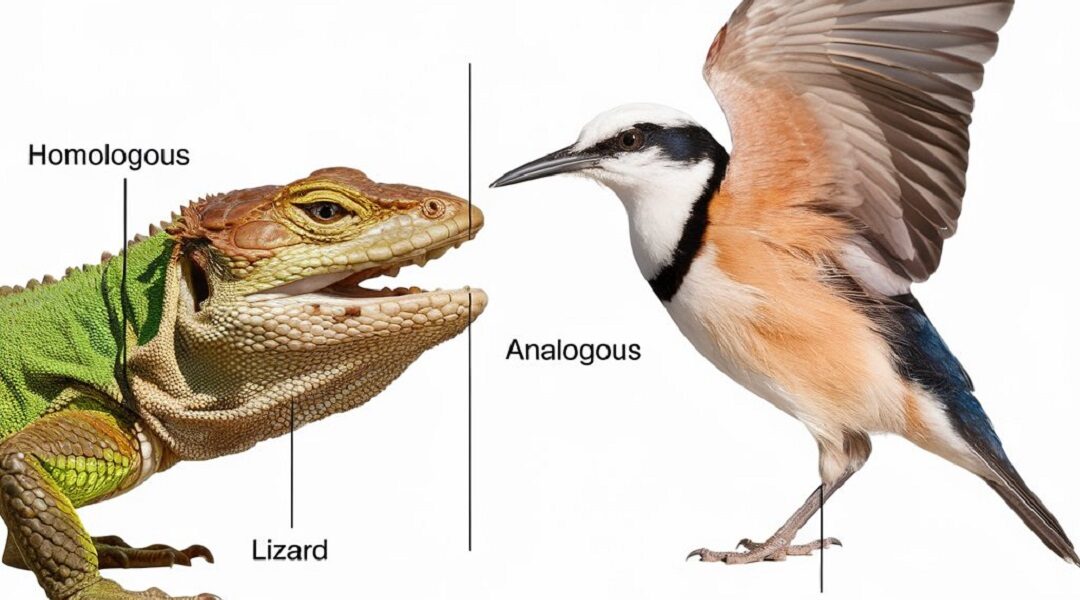Homologous and analogous organs
Through comparative anatomy, homologous and analogous organs can be found and differentiated in different organisms by contrasting them.
| Homologous organs | Analogous organs | |
|---|---|---|
| Definition | Organs similar in structure with different functions. | Those organs with a different origin that perform the same function. |
| Characteristics |
|
|
| Type of evolution | Divergent. | Convergent. |
| Presence | It can be observed in species that inhabit different environments. | They are present in species that inhabit similar environments. |
| Examples | The wings of bats and the arms of a chimpanzee are homologous organs. | Bat wings and bird wings are analogous organs. |
What are homologous organs?
Homologous organs are those that are similar in their internal structure , but that perform different functions depending on the species.
Homology is usually present in bodies because they come from a common ancestral organ.
The functions performed by homologous organs can be completely different because the species have adapted to the characteristics of the environment in which they develop.
The development of homologous organs occurs through divergent evolution , where two related species change a common ancestral structure during their evolution in order to survive by performing different functions.
This is why organs are said to be homologous when they have the same evolutionary origin , that is, a common ancestor, even though they have developed to fulfill functions for different purposes.
Example: The forelimbs of vertebrates, such as the arms, the wings of birds and the fins of a dolphin are homologous organs because they come from the same common ancestor, while performing totally different functions.
What are analogous organs?
Analogous organs are those that are morphologically similar or carry out similar functions despite having a different genetic origin .This means that the origin and embryonic development of analogous organs is not the same, even if their structure is similar or they perform the same function.
Typically, analogy occurs when species have evolved separately but have had to adapt to the same type of environment .
This development process is possible thanks to convergent evolution . Here, organisms that have had to evolve completely separately develop similar characteristics because the environmental conditions in which they develop are quite similar.
Sharks and dolphins are two species that have had to evolve convergently.
Example: the wings of birds and insects are morphologically different, but both perform the same function because they allow these species to fly.
Analogous structures, unlike homologous structures, have similar functions, but there is no direct sharing of ancestry . These structures arise as a result of convergent evolution, that is, the ancestors of these species lived in similar environments or suffered similar selective pressures, and the advantageous characteristics were maintained in these groups.
→ Example of analogy
An example of analogy appears when we analyze the wings of birds and bats. Although these structures look similar and relate to flight, a detailed examination reveals striking differences: bird wings have feathers along the entire length of the arm, while bat wings feature membranes between the fingers.
Additionally, these animals do not share a common ancestor with wings from which they inherited this characteristic. The ancestor that gave rise to birds differs from the one that led to bats.
Importantly, we consider the wings of bats and birds as analogous when discussing wings, but we view them as homologous when examining forelimbs.
This is because these organisms had a common origin in a Tetrapod ancestor. We can therefore see that the classification as analogous or homologous may vary depending on the level at which we are comparing the species.
Conclusion: In summary, homologous and analogous organs highlight the diverse strategies of evolution and adaptation in the natural world. Homologous organs, sharing a common ancestry, demonstrate how different species can evolve similar structures for different functions, while analogous organs illustrate how different species can develop similar traits independently in response to similar environmental challenges. Understanding these concepts deepens our appreciation of evolutionary biology and the intricate connections among living organisms.
FOR FERDUR INFORMATION VISIT :https://proteomics.uk/




